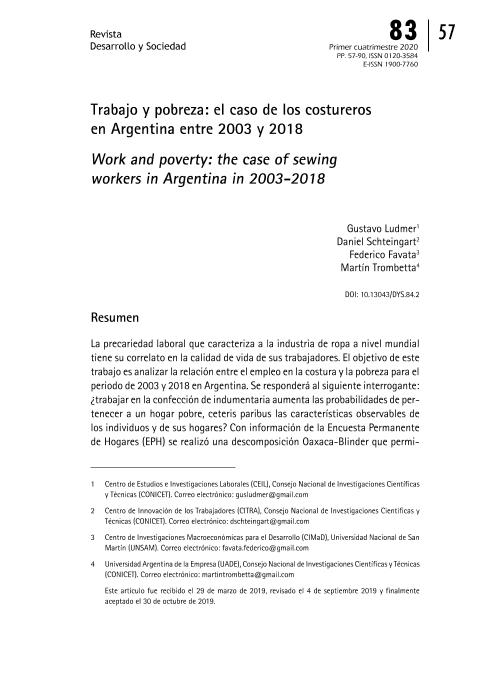Artículo
La precariedad laboral que caracteriza a la industria de ropa a nivel mundialtiene su correlato en la calidad de vida de sus trabajadores. El objetivo de estetrabajo es analizar la relación entre el empleo en la costura y la pobreza para elperiodo de 2003 y 2018 en Argentina. Se responderá al siguiente interrogante:¿trabajar en la confección de indumentaria aumenta las probabilidades de pertenecer a un hogar pobre, ceteris paribus las características observables delos individuos y de sus hogares? Con información de la Encuesta Permanentede Hogares (EPH) se realizó una descomposición Oaxaca-Blinder que permitió concluir que a) los trabajadores de la costura presentan niveles de pobrezasignificativamente mayores que el resto, b) que tales diferencias se explicanen parte por atributos personales (baja calificación, por ejemplo) y c) tambiéndebido a que trabajar en el sector de indumentaria incrementa las probabilidades de ser pobre, aun controlando por atributos personales. Precarious work is a general feature of the clothing industry around the world and has an impact on the quality of life for those who work in it. The aim of this work is to analyze the link between working in the sewing industry and poverty for the 2003-2018 period in Argentina. We intend to answer the question ‘does working in the sewing industry raise one’s odds of living in a poor household, conditional on observable attributes of households and individuals?’ Using data from household surveys, we perform a Oaxaca-Blinder decomposition and conclude that: a) sewing workers show significantly higher levels of poverty than the rest of the workers in the economy, b) such differences are partly explained by individual attributes (such as low skills, for instance), and c) they are also explained by the fact that working in the sewing sector raises the odds of being poor, controlling for observable attributes
Work and poverty: The case of sewing workers in Argentina in 2003-2018
Título:
Trabajo y pobreza: El caso de los costureros en Argentina entre 2003 y 2018
Fecha de publicación:
01/01/2020
Editorial:
Universidad de los Andes. Facultad de Economía
Revista:
Desarrollo y Sociedad
ISSN:
0120-3584
e-ISSN:
1900-7760
Idioma:
Español
Tipo de recurso:
Artículo publicado
Clasificación temática:
Resumen
Palabras clave:
OAXACA-BLINDER
,
INFORMALIDAD LABORAL
,
ARGENTINA
Archivos asociados
Licencia
Identificadores
Colecciones
Articulos(CITRA)
Articulos de CENTRO DE INNOVACION DE LOS TRABAJADORES
Articulos de CENTRO DE INNOVACION DE LOS TRABAJADORES
Citación
Ludmer, Gustavo; Schteingart, Daniel Matías; Favata, Federico; Trombetta, Martín; Work and poverty: The case of sewing workers in Argentina in 2003-2018; Universidad de los Andes. Facultad de Economía; Desarrollo y Sociedad; 2020; 84; 1-1-2020; 57-90
Compartir
Altmétricas




